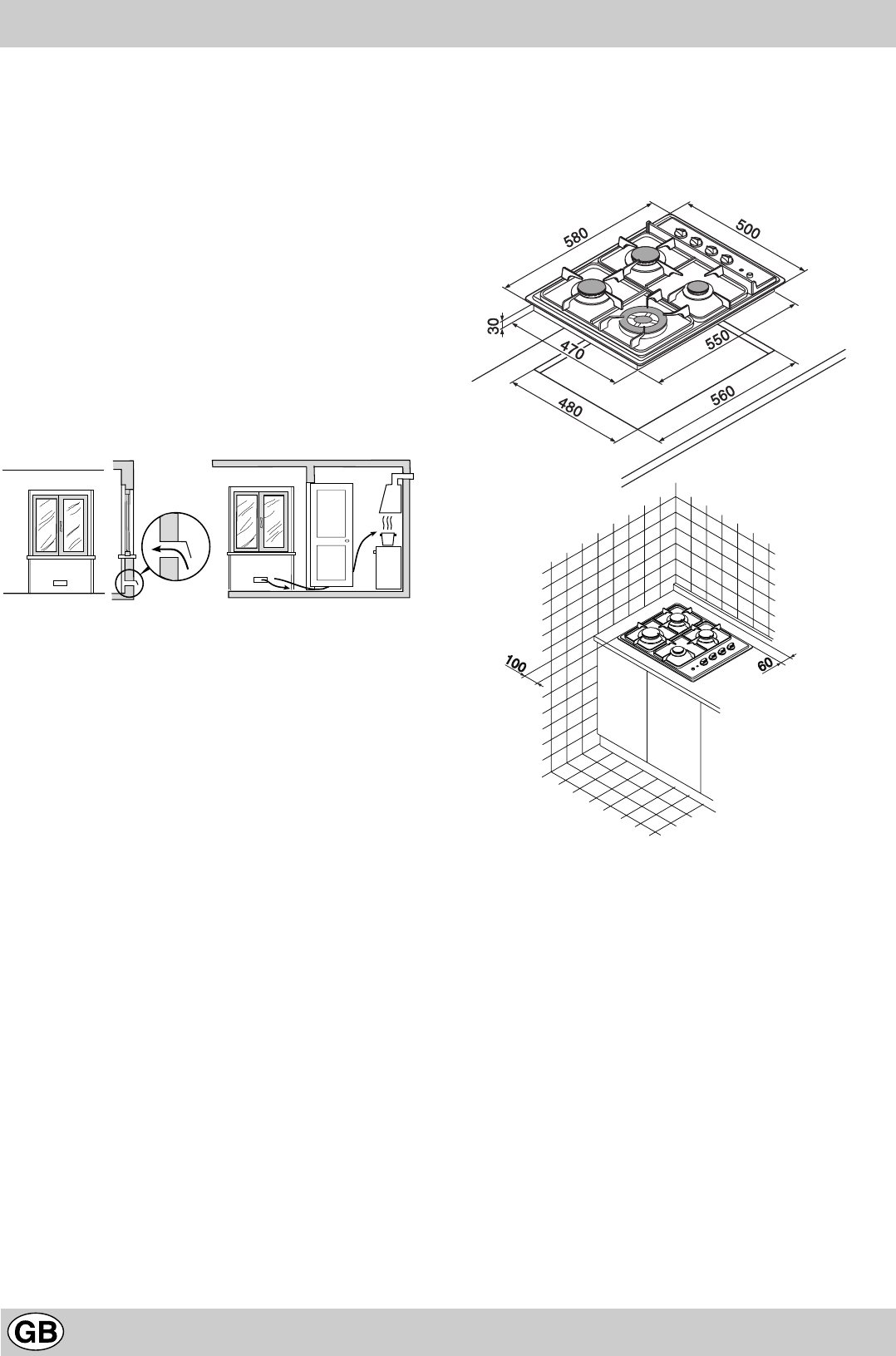
4
The hob must be at least 60 mm from the rear wall. If the
hob is to be installed near a corner, it must be at least 100
mm. from the side wall (fig.5). If the hob is installed on a
base unit with doors, hob operation is not influenced by the
opening and closing of these doors.
combustion of the gas and for ventilating the same room.
Air must be taken in naturally through permanent apertures
made in the outside walls of the room or through single or
branching collective ventilation ducts in compliance with the
standards in force. The air must be taken directly from the
outside, from an area far from sources of pollution.
The ventilation aperture must have the following
characteristics (fig.3A):
· total free cross section of passage of at least 6 cm² for
every kW of rated heating capacity of the appliance, with
a minimum of 100 cm² (the heating capacity is indicated
on the rating plate);
· it must be made in such a way that the aperture, both on
the inside and outside of the wall, cannot be obstructed;
· it must be protected, e.g. with grills, wire mesh, etc. in such
a way that the above-mentioned free section is not reduced;
· it must be situated as near to floor level as possible.
Detail A Adjacent Room to be
room ventilated
A
Examples of ventilation holes Enlarging the ventilation slot
for comburant air between window and floor
Fig. 3A Fig. 3B
The air inflow may also be obtained from an adjoining room,
provided the latter is not a bedroom or a room where there
is a risk of fire, such as garages, mews, fuel stores, etc. and
is ventilated in compliance with the standards in force.
Air from the adjoining room to the one to be ventilated may
be made to freely pass through permanent apertures with a
cross section at least equal to that indicated above. These
apertures may also be obtained by increasing the gap
between the door and the floor (fig.3B). If an electric fan is
used for extracting the combustion products, the ventilation
aperture must be increased in relation to its maximum
performance. The electric fan should have a sufficient
capacity to guarantee an hourly exchange of air equal to 3-
5 times the volume of the kitchen. Prolonged, intensive use
of the appliance may require extra ventilation, e.g. an open
window or a more efficient ventilation system by increasing
the extraction power of the electric fan if installed. Liquid
petroleum gas descends towards the floor as it is heavier
than air. Apertures in the outside walls in rooms containing
LPG cylinders should therefore be at floor level, in order to
allow any gas from leaks to be expelled. Do not store LPG
cylinders (even when empty) in basements/rooms below
ground level; it is advisable to keep only the cylinder in use
in the room at any one time and connected far from heat
sources which could raise its temperature to above 50 °C.
Fitting into modular kitchen units
For correct operation of the hob built into a kitchen unit or
other compartment, the latter must be suitable.
The installation diagram plus dimensions of the housing hole
is given in fig. 4.
fig.5
fig.4
Instructions for the installer
Installation above an oven
Suitable precautions must be taken to ensure that the
installation is in compliance with current accident-prevention
regulations regarding electrical and gas connections.
Both the electricity supply cable and the gas pipe must not
touch hot parts of the oven housing, in order to avoid
overheating. When installing above a built-under oven without
forced cooling ventilation, suitable air vents should be
provided for as shown in fig.6 (inlet at least 200 cm² from the
bottom, outlet at least 120 cm² from the top part) to allow
adequate ventilation inside the housing unit.
Also a wooden panel "A" should be installed beneath the
hob as insulation, positioning it at a minimum distance of 15
mm from the hob housing (fig.6).
Fixing to the housing unit
Proceed with fixing to the housing unit as follows (fig.7):
· mount the hooks "B", partly tightening the provided screws
"A" into the relative holes;
· position the provided sealing gasket "X" 5÷6 mm from the
edge of the installation hole, matching up the two ends of














